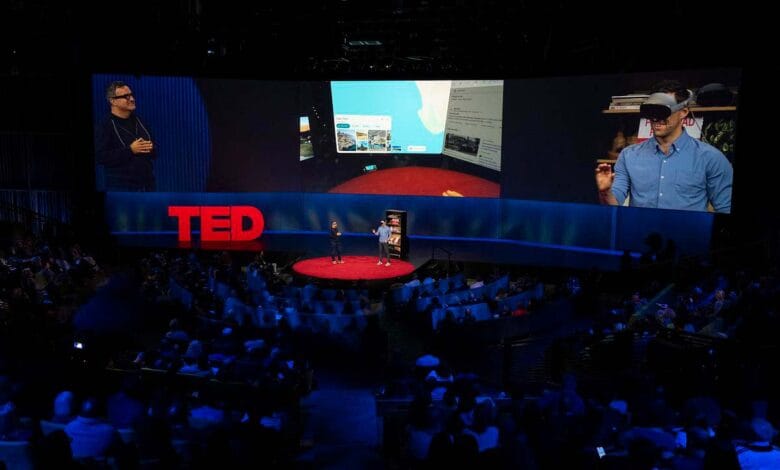
In a stunning display of technological innovation, Google has partnered with Samsung to unveil their next generation of wearable technology at TED 2025. This collaboration marks Google’s triumphant return to the smart eyewear market, nearly a decade after the initial Google Glass experiment. The announcement showcased two groundbreaking products: Project Astra smart glasses and Project Moohan mixed reality headsets, both powered by Google’s new Android XR platform and enhanced with Gemini AI integration.
Google Smart Glasses: A Revolutionary Comeback at TED 2025
The new Google smart glasses represent a significant leap forward in wearable technology, combining AI capabilities with an unobtrusive design. Codenamed Project Astra, these glasses look remarkably similar to ordinary eyewear, addressing one of the major criticisms of the original Google Glass – its conspicuous appearance.
“We’ve reimagined what smart glasses can be,” explained Sarah Chen, Google’s Head of Wearable Technology, during the TED 2025 keynote. “Project Astra isn’t just about displaying information; it’s about understanding your world and enhancing your interaction with it.”
Unlike the original Google Glasses released in 2013, the new Project Astra offers a more refined and consumer-friendly approach. The glasses feature a built-in display that overlays digital information onto the physical world without obstructing the user’s normal vision. This subtle integration allows wearers to access information without the social awkwardness that plagued earlier iterations.

Mixed Reality Headsets: Project Moohan Specifications and Features
One of the most impressive features demonstrated at TED was the innovative “Memory” function. This capability allows the glasses to track objects in the user’s environment, essentially remembering where items are placed and helping locate them later. Imagine never losing your keys again – the glasses can simply guide you to where you last left them.
While Project Astra focuses on everyday augmented reality, Samsung’s Project Moohan mixed reality headsets target more immersive experiences. These headsets feature advanced eye-tracking technology and powerful processing capabilities, positioning them as direct competitors to Apple’s Vision Pro.
The technical specifications of Project Moohan are impressive:
- Powered by Qualcomm’s Snapdragon XR2+ Gen 2 chipset
- Equipped with pancake lenses featuring precise eye tracking
- Support for both eye and hand tracking input methods
- Foveated rendering for enhanced visual quality
- Wired external battery design for extended use
- Seamless integration with Google services including Maps, Photos, and YouTube
During the demonstration, Samsung’s engineers showcased how the mixed reality headsets can switch effortlessly between virtual and augmented reality modes, creating what they called a “fluid reality experience.” This flexibility allows users to remain aware of their surroundings when necessary or fully immerse themselves in virtual environments when desired.
Google Mixed Reality Glasses: The Future of Wearable Technology
The Google mixed reality glasses unveiled at TED 2025 demonstrate the company’s renewed commitment to wearable technology. What sets these devices apart from previous attempts is their deep integration with artificial intelligence, specifically Google’s Gemini AI assistant.
“These aren’t just displays you wear on your face,” noted Dr. Michael Park, Lead AI Researcher at Google. “They’re intelligent companions that understand context, anticipate needs, and enhance human capabilities.”
The integration of Gemini AI in smart glasses enables natural language processing and contextual awareness. For example, the glasses can translate foreign language text in real-time as you look at it, transcribe conversations as they happen, or provide information about landmarks simply by looking at them.
This AI integration extends to both Project Astra and Project Moohan, creating a unified experience across different form factors. Whether you’re wearing the lightweight everyday glasses or the more immersive headset, the same AI capabilities and user interface remain consistent.
Android XR: The Platform Powering Google’s New Mixed Reality Ecosystem
The Android XR platform serves as the foundation for Google’s new ecosystem of mixed reality devices. This specialized version of Android is designed specifically for extended reality applications, providing developers with tools to create immersive experiences that work across both the smart glasses and mixed reality headsets.
“Android XR represents years of research in spatial computing,” explained David Kim, Director of XR Platforms at Google. “We’ve built it from the ground up to understand three-dimensional spaces and how humans interact with digital objects in the physical world.”
The platform includes enhanced versions of Google’s core services, optimized for spatial computing. For example, Google Maps in Android XR can overlay directions directly onto the real world, while YouTube can place virtual screens that follow you as you move through your home.
For developers, Android XR provides a unified framework that simplifies creating applications for different XR devices. This approach addresses one of the major challenges in the XR space – fragmentation – by providing consistent development tools across the ecosystem.
Google Glasses Evolution: From Google Glass to Project Astra
The journey from the original Google Glass to Project Astra represents a fascinating evolution in the company’s approach to wearable technology. When Google Glass launched in 2013, it was ahead of its time but faced significant challenges in terms of public acceptance, privacy concerns, and practical utility.
“We learned valuable lessons from our first attempt,” admitted Chen during a panel discussion at TED. “Project Astra incorporates those learnings – it’s more discreet, more powerful, and designed with privacy as a core principle.”
The original Google Glass featured a small display positioned above the user’s line of sight, which proved distracting and limited in functionality. Project Astra integrates the display more naturally into the lens itself, using advanced waveguide technology to project images directly into the user’s field of view.
Privacy concerns have also been addressed with visible indicators when the glasses are recording or capturing images, along with physical controls that allow users to quickly disable all sensors. These features aim to make bystanders more comfortable around the technology while giving users greater control over their privacy.
Smart Glasses Technology: How Project Astra Changes the Game
The smart glasses technology showcased at TED 2025 represents years of research and development in miniaturization and AI integration. Project Astra’s technological breakthroughs extend beyond just the display system to include advanced sensors and processing capabilities.
The glasses include a sophisticated array of sensors, including:
- Low-power cameras for environmental understanding
- Microphones for voice commands and ambient sound processing
- Accelerometers and gyroscopes for motion tracking
- Light sensors for adaptive display brightness
- GPS for location awareness
All these components are packed into a form factor that weighs just slightly more than regular prescription glasses. This achievement in miniaturization addresses one of the major barriers to adoption for previous smart glasses – comfort for all-day wear.
The processing is handled by a custom-designed chip that balances performance with power efficiency. Most intensive computing tasks are offloaded to the user’s smartphone or the cloud, allowing the glasses themselves to maintain a slim profile while still delivering powerful capabilities.
Augmented Reality Glasses: Real-World Applications and Benefits
These augmented reality glasses can overlay digital information onto the physical world without obstructing the user’s normal vision. This capability opens up numerous practical applications across various domains.
Education Transformed
The application of mixed reality in education allows students to visualize complex concepts in three dimensions. Imagine a biology class where students can see a beating heart floating in front of them, or a history lesson where ancient civilizations are reconstructed before their eyes.
“We’re moving beyond textbooks to experiential learning,” explained Dr. Emily Rodriguez, an education technology researcher who spoke at TED 2025. “When students can manipulate 3D models of molecules or walk through historical events, retention and understanding improve dramatically.”
Google demonstrated educational applications where students wearing Project Moohan headsets could collaborate on virtual science experiments, with the teacher able to guide and monitor their progress in real-time.
Healthcare Revolution
Healthcare applications of mixed reality include surgical training and patient data visualization in real-time. Surgeons wearing Project Astra glasses could see patient vital signs without looking away from the operating field, while medical students could practice procedures on virtual patients.
“The potential for training is enormous,” said Dr. James Wilson, a neurosurgeon who tested the technology. “Medical students can practice the same procedure dozens of times in mixed reality before ever touching a real patient.”
Beyond training, the technology shows promise for telemedicine, allowing specialists to guide procedures remotely by seeing exactly what the on-site physician sees and providing guidance through visual overlays.
Entertainment Reimagined
Entertainment with smart glasses transforms passive viewing into interactive experiences. Movies could extend beyond the screen, with characters appearing to walk around your living room. Games could blend with your physical environment, turning your home into a playing field.
During the TED demonstration, attendees experienced a concert where virtual performers appeared on stage alongside real musicians, creating a hybrid performance that would be impossible in traditional venues.
“This isn’t just a new screen to watch content on,” explained Maria Gonzalez, Head of Entertainment Partnerships at Google. “It’s a new medium that blends digital and physical in ways that change how stories are told and experienced.”
Market Positioning and Competition
Google and Samsung are positioning their XR offerings as more affordable alternatives to Apple’s Vision Pro, which currently retails for $3,500. While exact pricing wasn’t announced at TED 2025, industry analysts expect Project Moohan to be priced competitively around $2,000, with Project Astra potentially available for under $1,000.
The mixed reality smart glasses from Google and Samsung blend the physical and digital worlds in ways previously only seen in science fiction. This positions them uniquely in a market that has seen various approaches to wearable displays.
“Google and Samsung are taking a more practical approach than some competitors,” noted tech analyst Jason Kim. “Rather than promising a complete replacement for your smartphone or computer, they’re focusing on specific use cases where this technology truly adds value.”
While the exact Google XR headset release date hasn’t been confirmed, industry experts anticipate a launch in late 2025, with developer kits becoming available earlier to build the ecosystem of applications.
Expert Opinions and Future Outlook
The reaction from TED 2025 attendees and industry experts has been overwhelmingly positive, with particular praise for the AI integration and form factor improvements.
“What impressed me most was how natural the interaction felt,” said Maria Lopez, a technology reviewer who tried both devices. “The voice commands, gesture controls, and eye tracking all worked together seamlessly. It didn’t feel like I was using technology – the technology was simply enhancing my natural capabilities.”
Looking to the future, experts predict several trends in the evolution of this technology:
- Continued miniaturization – Future iterations will likely become even more indistinguishable from regular eyewear
- Enhanced AI capabilities – As Gemini AI evolves, the glasses will become more predictive and personalized
- Expanded ecosystem – More third-party developers will create applications specifically for these platforms
- Social features – Future versions may enhance person-to-person interactions through shared AR experiences
“We’re just scratching the surface of what’s possible,” concluded Chen in her closing remarks at TED. “As these devices become more integrated into our daily lives, we’ll discover use cases we haven’t even imagined yet.”
Conclusion
Google’s partnership with Samsung for Project Astra and Project Moohan represents a significant milestone in the evolution of wearable technology. By combining Samsung’s hardware expertise with Google’s software and AI capabilities, these companies have created devices that address many of the limitations that hindered previous smart glasses and mixed reality headsets.
The integration of powerful AI, natural user interfaces, and practical form factors suggests that we may finally be reaching the tipping point where smart eyewear becomes mainstream. As these technologies continue to evolve and find applications across education, healthcare, entertainment, and everyday life, they have the potential to fundamentally change how we interact with information and our environment.
While challenges remain – particularly around privacy, social acceptance, and building a robust ecosystem of applications – the vision presented at TED 2025 offers a compelling glimpse into a future where the line between digital and physical continues to blur, enhancing human capabilities in ways that were once the domain of science fiction.




